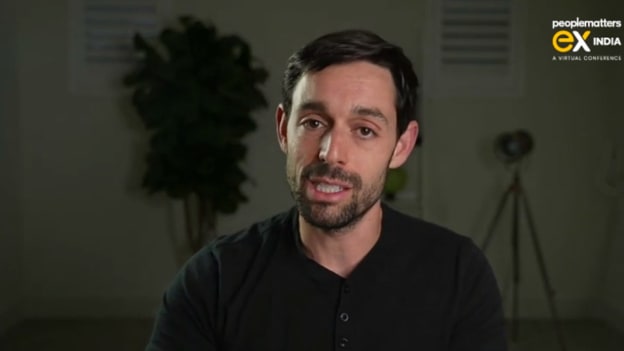Three elements of an experience that makes people want to come to work

In today's world of work, what it means to be an employee has changed. Candidates for a job are looking not just at the work and the pay, but at the entire experience of working for the organisation: the leadership style, the growth and development opportunities. But are companies matching these expectations? Not quite, according to futurist Jacob Morgan.
Delivering the keynote address at People Matters EX India Conference today, he said: “Traditionally, organisations have approached this by simply focusing on employee engagement programs. And the challenge with employee engagement programs in most organisations around the world is that they fundamentally they operate like an adrenaline shot.”
In other words, he pointed out, organisations are offering perks that act as short-term fixes, making employees temporarily happy—but the contentment does not last into the long term.
“We have to move away from creating an organisation where we assume people need to be there, to creating an organisation where people actually want to be there,” he said.
How does that work, though? Morgan suggested focusing on three specific aspects of work that organisations are able to control, shape, and design: culture, technology, and physical space.
Physical space and the manifestation of values
Physical space, according to Morgan, comprises 30 percent of the employee experience. And it is exactly what it sounds like, he said: “This is the art that hangs on the wall, this is the cubicles or the open floor plan.”
However, as he pointed out, COVID-19 has added several more dimensions to the physical space of an office. One is safety: employees have to feel safe and taken care of before they can even think of wanting to be there. Another is flexible work: the environments that organisations design have to be conducive to the new working model.
Going beyond these immediate urgent considerations, Morgan said that in the long term, an organisation's physical spaces need to reflect its intangible values.
“The other critical aspect of a physical space is making sure that your values are physically manifested in the spaces in which employees work. In other words, if your values include things like trust, transparency, or collaboration, you should actually be able to see that manifested in the spaces in which employees work,” he said.
He suggested a simple test for leaders and HR professionals: write down the organisation's values on a sheet of paper, and then walk around the premises and see whether those values come to life in the physical surroundings. “Do you see trust, do you see collaboration, do you see communication, are these things physically being manifested in the spaces in which you work?” he asked. “If not, then those values are useless.”
Technology: keeping business going
Technology accounts for another 30 percent of the overall employee experience, Morgan said. “Technology is the central nervous system of the organisation,” he observed. “This is what connects people, this is what allows business to happen.”
He pointed out, though, that COVID-19 has greatly magnified the role that technology plays—without it, the economic and business impact would be far greater, and the present levels of communication and collaborative work impossible. As a result, the pandemic has accelerated digital transformation and technology adoption to a degree that might otherwise never be attained. “ These organizations have done what they've been trying to do for 20 years, in just a matter of a couple of weeks or months in some cases,” he said.
Culture, the side effects of work
Corporate culture makes up the last and largest 40 percent of employee experience, and it is also the most difficult to assess or change simply because, unlike the other two elements, it cannot be affected just by investing money or resources, Morgan said.
“Culture is very human,” he pointed out. “It deals with our emotions, with our feelings. That's not easy. Humans don't like dealing with emotions and feelings, especially leaders.”
Describing culture as the side effects of working for an organisation, he compared it to a prescription drug: there may be unpleasant side effects on the user's health and appearance, that make people refuse to use it. In the same way, he said working with an organisation with an undesirable culture can have unpleasant side effects on the employee's health and personal life.
“If you're not willing to take the prescription drug, why would you be willing to work at a company that has the same side effects?” he asked rhetorically.
But in the same way, the side effects can be positive: giving people the opportunity for growth, offering them empowerment and a sense of belonging, providing purpose and meaning.
The employee experience equation
Put together, the three elements of culture, technology, and physical space form the employee experience equation. It is easy, Morgan said, to make this equation come out positive during good times—when the business is profitable and the economy is booming—but organisations that can make the equation work out even during bad times like the current crisis are the ones that can truly win the battle for the future of work.
He offered three suggestions for creating the desired outcomes: firstly, to filter all the decisions made through the employee experience equation, and consider how culture, technology, and space will be impacted.
Secondly, to consider what are the moments that matter in the lives of employees, and how to create experiences around those moments.
And thirdly, to think of the organisation as a laboratory, where solutions and approaches can be tested and failure should not be a cause for fear. He recounted: “I interviewed the CEO of an organisation here in the States, and he was jokingly telling me about a message he gave to his employees. He said: 'Hey guys, I don't know all the answers. This is my first pandemic.' And guess what? This is our first pandemic for a lot of people. We don't know the right answers, we don't always have the right approach, and that's okay.”
















